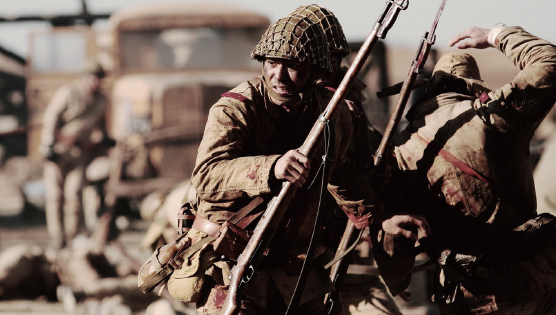I had a chance to check out the Korean WWII film "My Way"
Here's the trailer that doesn't give too much away, but you're not going to watch this flick for plot twists and turns anyway. You're a wargamer so you're going to be counting the rivets on the tanks or trying to figure out what sort of leadership rating you'd give to each of the Japanese officers:
 |
Our hero gets involved in a riot that sees him and a number of his Korean comrades arrested and drafted into the Imperial Japanese army as punishment. Before you can say "a training montage usually has more than one shot" we're at the front lines with our band of Korean soldiers trying to survive the horrors of war as well as their sadistic Japanese overseers.
 |
| All because he didn't fill out his TPS report... |
Over the remainder of the film this band gets involved in a number of battles — or defeats, rather — as they are constantly captured and pressed into service to fight for their latest set of captors. The battles are fairly well done, with a mix of combatants you rarely see on film (Soviet BT- 7 tanks vs. Japanese infantry charge for example), are suitably brutal and have a decent (though not complete) amount of historical accuracy.
 |
| Check out that weird cylinder turret on the tank. BT-7, right? |
In some cases the battles feel like nothing more than a mad lemming-like rush into overwhelming enemy firepower, but they're still gripping enough to be worth watching. With each defeat comes an obligatory death scene though, and here's where the film broke down for me. These death scenes are played very melodramatically, almost like parodies of "Oscar bait" death acting. One or two would have been fine, but when one of Kim's allies gets three (THREE!) death scenes after charging a German machine gun position my eye-rolling became too much to bear. Like a villain in a bad horror movie, just when you think he's dead he pops back up, lashing out with more drama soaked monologue-ing.
 |
| "No, your friend is only MOSTLY dead. There's a big difference between mostly dead and all dead." |
Get to the Good Stuff
As a wargamer, you'll likely be looking at the film from a different perspective than most audiences. The annoying melodrama I mentioned can be overlooked if the film gets the battles right. Here's what you get in "My Way":- Japanese unit under sniper attack in Mongolia. Interesting skirmish scenario fodder.
- Japanese infantry charge against Soviet attack using BT-7 tanks. My favorite battle of the movie.
- Soviet infantry charge against German positions in an battle scarred urban landscape. There's a strange looking German tank involved, but shots were too quick for me to make it out.
- D-Day, but from the German perspective. Pretty historically inaccurate, but interesting to see the battle from the entrenched German perspective.


I'd never heard of this, but now I'm going to have to check it out, thanks!
ReplyDeleteGlad I could bring it to your attention! :)
DeleteGood find, I will get a copy. I just discovered a recent Japanese war film called "Oba The Last Samurai" The Japanese view on the defence of Saipan. Great movie.
ReplyDeleteOh nice! I hadn't heard of that one. Putting it on my list. Thanks for the recommendation!
DeleteIt sounds fascinating. Thanks for noting it. It is culturally refreshing, even startling, to see war films from such a different viewpoint. I enjoyed Letters From Iwo Jima even if, at times, it seemed like a handful of primitively armed Japanese were minding their own business until a gazillion Americans came over the horizon and blasted them into pieces.
ReplyDelete